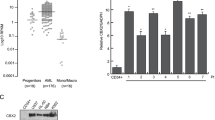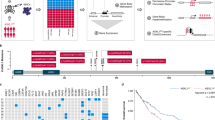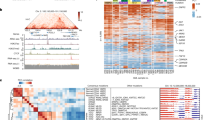Abstract
Background
The NSD2 p.E1099K (EK) mutation is shown to be enriched in patients with relapsed acute lymphoblastic leukemia (ALL), indicating a role in clonal evolution and drug resistance.
Results
To uncover 3D chromatin architecture-related mechanisms underlying drug resistance, we perform Hi-C on three B-ALL cell lines heterozygous for NSD2 EK. The NSD2 mutation leads to widespread remodeling of the 3D genome, most dramatically in terms of compartment changes with a strong bias towards A compartment shifts. Systematic integration of the Hi-C data with previously published ATAC-seq, RNA-seq, and ChIP-seq data show an expansion in H3K36me2 and a shrinkage in H3K27me3 within A compartments as well as increased gene expression and chromatin accessibility. These results suggest that NSD2 EK plays a prominent role in chromatin decompaction through enrichment of H3K36me2. In contrast, we identify few changes in intra-topologically associating domain activity. While compartment changes vary across cell lines, a common core of decompacting loci are shared, driving the expression of genes/pathways previously implicated in drug resistance. We further perform RNA sequencing on a cohort of matched diagnosis/relapse ALL patients harboring the relapse-specific NSD2 EK mutation. Changes in patient gene expression upon relapse significantly correlate with core compartment changes, further implicating the role of NSD2 EK in genome decompaction.
Conclusions
In spite of cell-context-dependent changes mediated by EK, there appears to be a shared transcriptional program dependent on compartment shifts which could explain phenotypic differences across EK cell lines. This core program is an attractive target for therapeutic intervention.
Similar content being viewed by others
Background
While the overall outcome with children with acute lymphoblastic leukemia (ALL) has improved dramatically, up to 20% of patients relapse making ALL one of the leading causes of cancer-related death in children [1, 2]. Genome-wide profiling studies have shown enrichment of mutations at relapse including somatic alterations in epigenetic regulators such as MSH6, SETD2, and NSD2 [3]. NSD2 is a key histone methyltransferase involved in monomethylation and dimethylation of lysine 36 of histone 3 (H3K36), a mark associated with active transcription [4]. Specifically, the recurrent gain of function mutation p.E1099K (EK) has been found to be enriched in patients with relapsed ALL [5].
The NSD2 EK mutation results in increased methyltransferase activity leading to a global increase in H3K36me2 levels (active mark) as well as the concomitant inhibition of EZH2-mediated H3K27me3 levels (repressive mark) in pediatric ALL [6, 7]. Our previous studies have shown knockdown of NSD2 in EK mutated B-ALL cell lines resulted in decreased proliferation, decreased clonal growth, and increased sensitivity to cytotoxic chemotherapeutic agents with no effect on NSD2 wildtype lines [5]. Other work also demonstrated changes in growth and clonogenicity as well as cellular adhesion upon CRISPR-mediated reversion of EK to wildtype in NSD2 mutated lines [7]. Interestingly, RNA-seq data from both studies revealed variable transcriptional reprogramming upon loss of NSD2 in different cell line models. While some common pathways were identified, such as cell adhesion and Rap1 signaling, collectively the data suggests cell-context-specific changes occur in response to mutated NSD2. Importantly, we also demonstrated minimal overlap in chromatin accessibility changes upon NSD2 knockdown in the three EK harboring cell lines [5]. Our current work addresses the transcriptional and chromatin accessibility heterogeneity observed as a result of the NSD2 EK mutation.
In this study, we investigate the role 3D genome organization plays in EK-mediated relapse. 3D genome organization refers to the strategic positioning of regulatory elements to regions best suited for the regulation of genome function. The organizational hierarchy is made up of multiscale structural units such as chromosomal territories, A/B compartments, topologically associating domains (TADs), and chromatin loops each of which play an important role in regulating gene expression [8, 9]. At the Mb scale, chromosomes are spatially divided into two major domains, A and B compartments, that correspond to active and inactive chromatins, respectively [10, 11]. At the sub-Mb scale, the genome can be further subdivided into highly self-interacting chromatin units referred to as TADs [10, 12, 13]. TADs play a major role in the regulation of gene expression by restricting the influence of regulatory elements to genes within the same TAD as well as insulating them from interactions with neighboring domains [14].
Dysregulation of higher-order genomic architecture in several disease models has been linked to changes in the epigenetic landscape [15,16,17,Full size image
NSD2 EK-mediated epigenetic changes correlate with 3D genome changes
We previously performed ChIP-seq on the RS4;11 NSD2 Low and NSD2 High cell lines [5]. For this work, we additionally performed ChIP-seq on the RCH and SEM NSD2 Low and NSD2 High cell lines for H3K36me2, H3K27me3, and H3K27ac epigenetic marks. As noted previously, H3K36me2 distribution shifted from predominantly promoter regions to intergenic regions in all three cell lines, most dramatically in the RS4;11 cell line (Fig. 7a). Conversely, H3K27me3 peaks shifted from intergenic regions to promoter regions (Fig. 7a). Notably, H3K27ac was found to be enriched at promoter regions with little difference in distribution (Fig. 7a).
NSD2 EK-mediated epigenetic changes correlate with 3D genome changes. a Bar plots showing distribution of annotated ChiP-seq peaks for each epigenetic mark for NSD2-Low and NSD2-High in each cell line. b Correlation boxplots of H3K36me2 ChIP-seq and cscore compartment switches. c Association barplots showing fraction of differential H3K36me2 chip-seq peaks (decreased, increased, and no change) at cscore compartment switches (AB, BA, and stable). d KEGG 2021 pathway enrichment analysis of genes upregulated from NSD2-Low to NSD2-High that overlap with B to A compartment switches and increased H3K36me2 peaks from all three cell lines. e IGV genome browser tracks showing an example of concordant changes in A/B compartments, H3K36me2, and gene expression from NSD2 Low to NSD2 High at the NCAM1 gene locus in all three cell lines
To examine the relationship between alterations in the distribution of H3K36me2 and A/B compartment switches, we categorized the A/B compartment switches into those that are AB, BA, or stable and assessed changes in H3K36me2. H3K36me2 peaks positively correlated with BA switches more significantly than with AB switches in each of the cell lines (Fig. 7b). We also identified that B to A compartment switches were associated with increased H3K36me2 (Fig. 7c). This data suggests that expansion of H3K36me2 as a result of NSD2 EK provides a more open chromatin landscape.
From previous work, we know that NSD2 regulates H3K36me2; therefore, we can reasonably argue that the H3K36me2-related gene expression changes are due to NSD2. Under this assumption, we calculated the percentage of gene changes that can be attributed to both B to A compartment switches/shifts and increases in H3K36me2 (Additional file 1: Fig. S9a). Approximately 16–30% of genes that were upregulated were within a decompacted compartment, while ~16% presented with increased H3K36me2. For the differentially expressed genes that cannot be attributed to NSD2-related compartment switches, we believe these might be the result of indirect effects.
Next, to examine the relationship between alterations in the distribution of H3K36me2 and intra-TAD activity, we categorized the intra-TAD activity changes into those that are decreased, increased, or stable and assessed changes in H3K36me2. Although there were few intra-TAD activity changes, we observed that increased intra-TAD activity predominantly consisted of increased H3K36me2 and that decreased intra-TAD activity predominantly consisted of decreased H3K36me2 (Additional file 1: Fig. S9b).
Lastly, to better understand the impact these changes have on downstream signaling, we performed pathway enrichment analysis for those differentially expressed genes that were associated with a compartment switch from B to A and an increase in H3K36me2 in any of the cell lines (Fig. 7d). Wnt signaling and cell adhesion were identified as the two most significant pathways. Interestingly, we observed a B to A compartment switch, increased H3K36me2 peaks, and increased gene expression at the NCAM1 gene locus in all three cell lines (Fig. 7e), one of the genes that is related to cell adhesion pathways. Importantly, while cell adhesion was identified in several of our pathway analyses, some genes were impacted by both 3D change and epigenetic modifications such as NCAM1, while NEO1 showed a compartment change but no change in H3K36me2. This highlights the convergence of NSD2 EK-mediated epigenetic modifications and 3D genome organization on downstream signaling.






